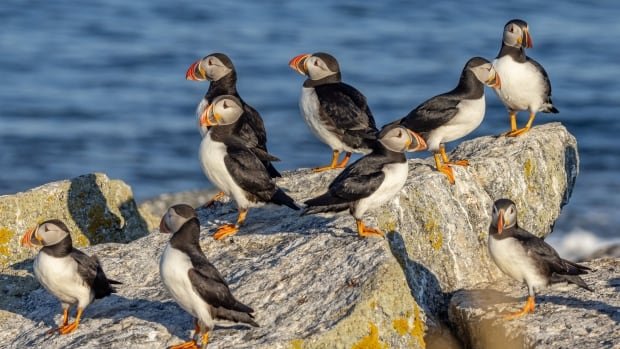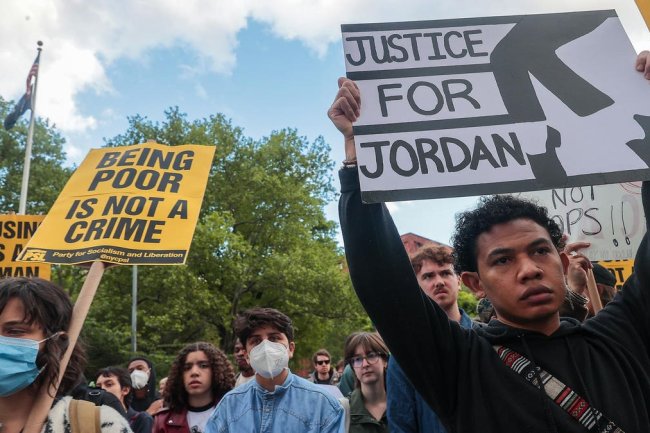How Newfoundland puffins helped save the bird's population in Maine
Atlantic Puffins loaf around on a rock in Maine. 50 years ago, Project Puffin started using puffin chicks from Newfoundland to repopulate the seabird's population in Maine. (Jean Hall)The Current23:39How Newfoundland puffins repopulated MaineThe Atlantic puffin population in Maine is fairly stable today. But as recently as the 1970s, hunting had made the seabird nearly non-existent in the state.Only 70 or so pairs lived on Matinicus Rock at the time, roughly 40 kilometres off the Maine coast."They used to breed on at least five other islands in Maine, but had not recolonized any of those islands on their own in about 100 years," said Steve Kress, former executive director of the Audubon Society's Seabird Institute.Kress, who first encountered the seabirds on Machias Seal Island in New Brunswick, partnered with the non-profit National Audubon Society to launch Project Puffin on July 4, 1973 — just over 50 years ago.Over the next decade and a half, they transported almost 2,000 puffin c



The Atlantic puffin population in Maine is fairly stable today. But as recently as the 1970s, hunting had made the seabird nearly non-existent in the state.
Only 70 or so pairs lived on Matinicus Rock at the time, roughly 40 kilometres off the Maine coast.
"They used to breed on at least five other islands in Maine, but had not recolonized any of those islands on their own in about 100 years," said Steve Kress, former executive director of the Audubon Society's Seabird Institute.
Kress, who first encountered the seabirds on Machias Seal Island in New Brunswick, partnered with the non-profit National Audubon Society to launch Project Puffin on July 4, 1973 — just over 50 years ago.
Over the next decade and a half, they transported almost 2,000 puffin chicks from Newfoundland to two historic breeding sites on Maine: Eastern Egg Rock Island and Seal Island National Wildlife Refuge.
"The idea was to hope that young puffins could be moved when they're just a few days old and they could be transferred from a large colony to a historic site," Kress told The Current guest host Robyn Bresnahan.
WATCH: Atlantic puffins loafing in Maine
50 years later, on the project's anniversary, their efforts are paying off. The puffin population in Maine has increased tenfold since 1973 — and they're even colonizing new parts of the state, according to Don Lyons, director of Conservation Science at Audubon's Seabird Institute.
"They're well on their way through the breeding season," he told Bresnahan. "They've been incubating eggs and many have had those eggs hatch into the young chicks."
Acting on a hunch
When Kress started the project, he said there were "significant gaps" in the scientific knowledge of puffins, such as what age they breed.
What was known, though, was that puffins could remember their hatching place — and they often returned there when they were old enough to breed.
That got Kress thinking: if puffin chicks were transported from Newfoundland to Maine, would they remember the sites on Maine where they were dropped off as their new breeding ground?
"That was just a hunch ... but I thought it was worth a try," he said.

Kress was in awe the first time he saw the puffin population in Canada.
"For someone who was just amazed to see even a single puffin, to go to Newfoundland where there was, like, hundreds of thousands of puffins in colonies was just awesome," he said.
But the transportation involved a lot of trial and error.
"We had to invent every step of the way because nobody had started a puffin colony before — or any kind of seabird colony before," he said.
Kress said they were initially transported in hollow juice cans inside of wooden boxes, with burlap doors to give them as much ventilation as possible. Up to 200 chicks were flown on a private jet to Maine each round.
The next step was building burrows to allow the puffins to breed. It took several trials, but by the project's third year, "we came up with an excellent burrow — built out of sod, L-shaped like a natural burrow," he said.

Once that was done, the waiting started. The first puffin returned to the relocation area within four years. The first bird carrying fish was spotted in 1981, "which meant that we had a chick," Kress said.
Social attraction
At one point, Kress was concerned by the lack of puffins returning to the relocation area. So to combat this, Kress pioneered a new conservation strategy using social attraction — based on the idea that puffins prefer to nest in groups.
"Maybe these puffins were just nervous about coming ashore," he said. "Maybe they were flying nearby but not seeing other puffins, [so] they would just venture on other puffin colonies."
To encourage puffin migration to the Maine release sites, Kress and his crew put up two types of decoys designed to look like puffins.
The idea was that if a passing puffin that was ready to nest saw the decoys, they would be more comfortable to nest on the release sites.
Kress's hunch was correct, and within a few years, there were signs that birds were nesting in the new puffin colony.
Conservation heroes
Biologist Ian Jones says seabirds are among the world's most endangered animals, so conservation efforts like Project Puffin are "fantastically important" to their survival and to general scientific knowledge.
"If there was a Nobel Prize for bird conservation or even for conservation, you know, Steve would be a candidate I would nominate," the Memorial University of Newfoundland professor told Bresnahan.
Despite their growth, Jones said that rising temperatures in the eastern Atlantic, "so around the British Isles, Norway, the Faroes and Iceland," may threaten the puffin population within the next 50 years.
"There's definitely some very worrying signs that the water is simply getting too hot to support the puffin's prey and the puffin populations," he said.
Still, he said the Atlantic puffins are doing relatively well compared to other seabird species, "and so that's cause for hope."
In the meantime, Audubon continues to monitor Maine's puffin population, using various publicly-broadcast cameras to study and learn from their habits.
Baby-led weaning's going great, thanks. pic.twitter.com/9qKO4XSBFh
—@exploreorgThe decoys are also still used on the islands today, and Lyons said the social attraction conservation technique has been adapted by other seabird conservation efforts around the world.
"A team of us, Steve and I with a bunch of collaborators, have recently compiled all of the projects that we're able to learn of around the world," he said.
"It's over 800 efforts that have now used these techniques of translocation and social attraction, and they've benefited around one-third of all the seabird species in the world."
What's Your Reaction?













